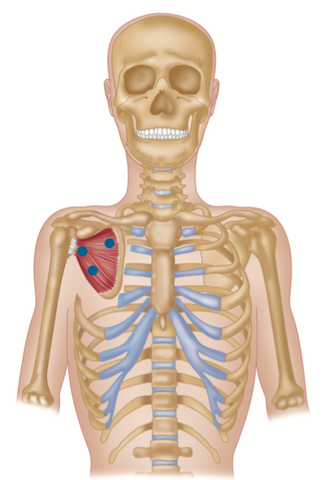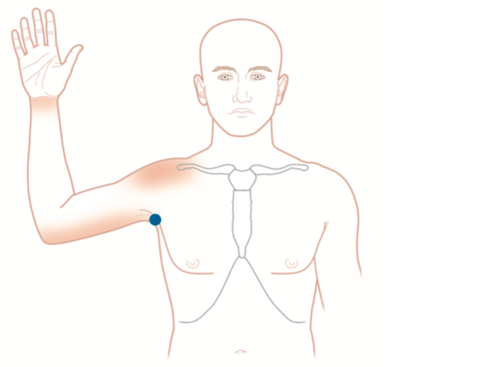Bicep and Subscapularis Tendinopathy | Deep Transverse Friction Massage
Treating Subscapularis - Dr. Jonathan Kuttner
Subscapularis trigger points are a potent cause of shoulder pain
[Latin sub, under; scapularis, pertaining to the scapula]
Subscapularis
A member of the rotator cuff, which comprises the supraspinatus, infraspinatus, teres minor, and subscapularis.
The rotator cuff helps hold the head of the humerus in contact with the glenoid cavity (fossa, socket) of the scapula during movements of the shoulder, thus helping to prevent dislocation of the joint.
The subscapularis constitutes the greater part of the posterior wall of the axilla.

Subscapularis Trigger Points
Origin
Subscapular fossa and groove along lateral border of anterior surface of scapula.
Insertion
Lesser tubercle of humerus. Capsule of shoulder joint.
Action
As a rotator cuff muscle, stabilizes glenohumeral joint, mainly preventing head of humerus being pulled upward by deltoid, biceps, and long head of triceps. Medially rotates humerus.
Antagonists: infraspinatus, teres minor.
Nerve
Upper and lower subscapular nerves, C5, 6, 7, from posterior cord of brachial plexus.
Basic Functional Movement
Example: reaching into back pocket.


Referred Pain Patterns
Axillary trigger point: strong zone (5–8 cm) of pain in posterior glenohumeral joint, with a peripheral diffuse zone. Also radiating down posterior aspect of arm and anteroposterior carpals of wrist.
Indications
Rotator cuff tendinopathy, adhesive capsulitis (frozen shoulder), decreased external rotation with abduction, severe pain over back
of shoulder, restricted range of shoulder movement, inability to reach behind back, pain on throwing, clicking/popping shoulders, stroke (hemiplegia).
Causes
Sports related (especially swimming crawl, repeated forceful overhead lifting, baseball pitching/catching, cricket), post shoulder fracture/ dislocation, frozen shoulder syndrome, sudden unexpected loading of shoulder (e.g. fall), post- fracture, prolonged immobility (sling).
Differential Diagnosis
Impingement syndromes. Rotator cuff dysfunctions. Thoracic outlet syndromes. Cervical radiculopathy (C7). Cardiopulmonary pathology.
Connections
Infraspinatus, pectorals, teres minor, latissimus dorsi, triceps brachii, posterior deltoid, supraspinatus.
Self Help
Subscapularis is mostly hidden but self-massage techniques can be helpful for part of muscle that is exposed in and around armpit.
More Articles About Frozen Shoulder
More Articles About the Rotator Cuff
Dry Needling for Trigger Points
This blog is intended to be used for information purposes only and is not intended to be used for medical diagnosis or treatment or to substitute for a medical diagnosis and/or treatment rendered or prescribed by a physician or competent healthcare professional. This information is designed as educational material, but should not be taken as a recommendation for treatment of any particular person or patient. Always consult your physician if you think you need treatment or if you feel unwell.
About Niel Asher Education
Niel Asher Education (NAT Global Campus) is a globally recognised provider of high-quality professional learning for hands-on health and movement practitioners. Through an extensive catalogue of expert-led online courses, NAT delivers continuing education for massage therapists, supporting both newly qualified and highly experienced professionals with practical, clinically relevant training designed for real-world practice.
Beyond massage therapy, Niel Asher Education offers comprehensive continuing education for physical therapists, continuing education for athletic trainers, continuing education for chiropractors, and continuing education for rehabilitation professionals working across a wide range of clinical, sports, and wellness environments. Courses span manual therapy, movement, rehabilitation, pain management, integrative therapies, and practitioner self-care, with content presented by respected educators and clinicians from around the world.
Known for its high production values and practitioner-focused approach, Niel Asher Education emphasises clarity, practical application, and professional integrity. Its online learning model allows practitioners to study at their own pace while earning recognised certificates and maintaining ongoing professional development requirements, making continuing education accessible regardless of location or schedule.
Through partnerships with leading educational platforms and organisations worldwide, Niel Asher Education continues to expand access to trusted, high-quality continuing education for massage therapists, continuing education for physical therapists, continuing education for athletic trainers, continuing education for chiropractors, and continuing education for rehabilitation professionals, supporting lifelong learning and professional excellence across the global therapy community.

Continuing Professional Education
Looking for Massage Therapy CEUs, PT and ATC continuing education, chiropractic CE, or advanced manual therapy training? Explore our evidence-based online courses designed for hands-on professionals.


















